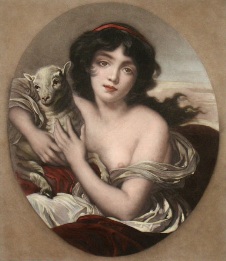Jean-Baptiste Greuze (21 August 1725 – 4 March 1805) was a French painter.
 Biography
BiographyBorn at Tournus, in Burgundy, he is generally said to have formed his own talent; this is, however, true only in the most limited sense, for at an early age his inclinations, though thwarted by his father, were encouraged by a Lyonnese artist named Grandon, or Grondom, who enjoyed during his lifetime considerable reputation as a portrait-painter. Grandon not only persuaded the father of Greuze to give way to his sons wishes, and permit the lad to accompany him as his pupil to Lyon, but, when at a later date he-himself left Lyon for Paris — where his son-in-law Grétry the celebrated composer enjoyed the height of favour — Grandon carried young Greuze with him.
Settled in Paris, Greuze worked from the living model in the school of the Royal Academy (Paris), but did not attract the attention of his teachers; and when he produced his first picture, "Le Père de famille expliquant la Bible a ses enfants," considerable doubt was felt and shown as to his share in its production. By other and more remarkable works of the same class Greuze soon established his claims beyond contest, and won for himself the notice and support of the well-known connoisseur La Live de Jully, the brother-in-law of Madame d'Epinay. In 1755 Greuze exhibited his "Aveugle trompé," upon which, presented by Pigalle the sculptor, he was immediately agréé by the Academy.
Towards the close of the same year he left France for Italy, in company with the Abbé Louis Gougenot, who had deserted from the magistrature — although he had obtained the post of conseiller au Châtelet in order to take the petit collet. Gougenot had some acquaintance with the arts, and was highly valued by the Academicians, who, during his journey with Greuze, elected him an honorary member of their body on account of his studies in mythology and allegory; his acquirements in these respects are said to have been largely utilized by them, but to Greuze they were of doubtful advantage, and he lost rather than gained by this visit to Italy in Gougenot's company. He had undertaken it probably in order to silence those who taxed him with ignorance of great models of style, but the Italian subjects which formed the entirety of his contributions to the Salon of 1757 showed that he had been put on a false track, and he speedily returned to the source of his first inspiration.
Legacy
In the second chapter of Arthur Conan Doyle's Sherlock Holmes story The Valley of Fear, Holmes' discussion of his enemy Professor Moriarty involves a Greuze painting, intended to illustrate Moriarty's wealth despite his small income.